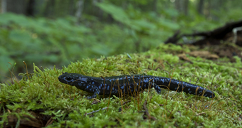Nature based-solutions, or NBS, work with our soils, plants, trees, and water alongside community partnership, education, and participation to strengthen our people and our natural areas to combat climate change.
Check out this video that describes Nature Based Solutions in Burlington.
When it comes to fighting climate change, nature is good, very good. In fact, as many scientific studies make clear that we can’t solve climate change without nature-based solutions. Nature-based solutions, or NBS, are land stewardship tools that work with plants and natural systems to strengthen communities in the face of climate change. In its simplest form, climate change comes from too much carbon in the air—and not enough in soil, water and plants. To solve this problem, we don’t just need new technologies—we need to protect and expand natural lands, forests, and plants that can soak up carbon. You can think of it as taking care of the land and trees—so they’ll take care of us.
Without our woods, solar panels, electric cars, and similar solutions just won’t cut it. The UN has determined that at least one-third of humanity’s efforts to keep our planet from dangerous overheating must come from nature-based solutions. In Burlington, we have a great resource in our many open lands and wild places. We have a vigorous forestry effort that provides both street trees and other urban forests to soak up carbon and form cooling green islands. But is Burlington’s investment in this approach adequate in comparison with our city’s other climate change effort? One thing is clear: nature-based solutions provide an extraordinarily high return on investment. If our citizens choose to, Burlington’s efforts to protect our natural areas could be more clearly incorporated into the city’s climate change strategy.

The city’s nature-based solutions to climate change could help homeowners and gardeners plant native shrubs and trees; incorporate composting stations in neighborhoods; purchase land strategically; plant trees; remove invasive species; regenerate thriving native ecosystems that produce large amounts of carbon-absorbing wood and plant matter; increase natural buffers along the Winooski River —and many other ideas that our leaders and citizens can bring to life.